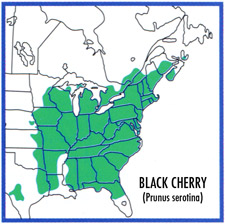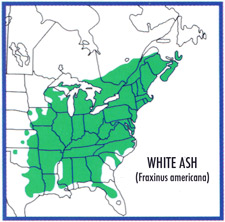Hardwoods
Black Cherry (Prunus serotina)


In cabinetmaking, cherry is rated one of the favorites because of its beauty and versatility it has warmth, personality and charm. As a craftwood it cuts,stains and sands beautifully, which makes it a hobby wood of choice.
American black cherry is widely used for paneling and as a veneer, burial caskets and other specialty items such as gunstocks, tobacco pipes, musical instruments, turnery, carvings, etc. It is only moderately durable for outdoor projects. Cherry wood is a favorite of all the domestic wood species.
Black Cherry Wood Description:
Cherry has a pale yellowish sapwood and a darker heartwood. The wood's colour deepens to its characteristic reddish brown, almost mahogany-like colour when exposed to the sun. The sapwood never darkens to the same colour of the heartwood. Cherry often shows a waving curly figure when finished. Heartwood can have dark spots or fine black lines that are actually gum pockets, that pose added challenges in finishing.
Finishing:
The grain pattern welcomes a full range of medium to dark finishes and bleaching treatments. The best way to achieve a uniform deep red colour is to let mother nature do her work rather than attempt staining. If you have to replace a board, remember in time, the sunlight will darken all cherry, even if it doesn't look like it matches in the beginning.
[Black Cherry info from The Wood Box.]
Where We Use Solid Cherry:
Euclid, Monet and Mondrian all come with beautiful, polished solid cherry
outer frames. Mozart, Miro and Modigliani display hand-turned and polished
solid cherry legs too.
White Ash (Fraxinus americana- Oleaceae family)


Ash is a great craft wood, but best known as the wood of choice for baseball bats. Other woods are stronger, but it has the best strength to weight ratio, and since most players do not want a bat greater than 32 oz. this becomes significant. For the same reason, it is used for tool handles, hockey sticks, and canoe paddles. Historically it was used for food bowls because it had no significant odor or taste. Curved components for chairs, snowshoes and boats capitalize on its wonderful bending properties. Really you can use it for any fine woodworking, with only your imagination as the limiting factor.
The Tree:
There are about 70 species in the world, and it is the oil in the wood that is chemically similar to olive oil, that links this tree with the Olive family. There are only about 17 types of this tree found in North America and only 2 or 3 that have any commercial significance. We predominately talk about white (Fraxinus Americana) and black (Fraxinus Nigra) ash in the lumber industry. The tree is never found in pure stands, but rather is widely distributed among other species.
Ash Wood Description:
The wood is straight-grained, open pored, and hard, with no distinctive taste or odor. It is tough and yet elastic, with high shock resistance and excellent steam bending characteristics. The wood is relatively stable with little downgrade in drying. It only occasionally shows interesting figure in crotch wood. It is not considered to be a durable wood when in contact with the ground. White ash has quite a clear white to pale yellow sapwood, with heartwood pulling more to the light to medium tone browns. Often the commercial lumber yards pull the sap out of the pile to form a more consistent white stock in the higher grades.
Finishing:
Ash finishes relatively easily and takes a beautiful stain. It is ring porous, so
if you are looking for a glass like finish you must use a pore filler. It can be
stained to look like oak as the grain pattern of the two woods is very similar.
Ash has less chatter (ie. the little lines) between the rows of open pores, so tends
to stain a little brighter than oak. You must sand carefully to eliminate cross
grain scratching, particularly if you are using a dark stain.
[Ash info from The Wood Box.]
Where We Use Solid Ash:
Miro and Modigliani rely on solid ash structural beams to support their cushioning.
Tulip Poplar (Liriodendron tulipifera)


Early settlers called the tulip tree "canoe wood" and harvested it for ships, paper mills and construction. Poplar is found in many furniture projects, toys and wood turnings because it is inexpensive, fairly workable and takes nails, screws and glue well. Poplar is also used quite often for more industrial purposes, such as the core of finer plywoods or for crates and pallets.
The Tree:
According to the University of Kentucky, the tulip poplar is the tallest North American hardwood tree. It is named for the distinctive green and orange tulip-shaped flowers that grow upright, high in the tree, in May and June. The flowers produce samaras, cone-shaped spirals of seeds, in fall, and the seeds themselves are extremely sharp. The four-lobed leaves grow 6 inches wide and turn yellow or brown in fall. Duck-bill shaped buds appear in winter.
Tulip Wood Description:
Yellow Poplar is a domestic hardwood. Poplar is straight grained and uniform in texture. The sapwood is white and often several inches thick. The heartwood is a yellowish brown to olive green sometimes streaked with dark green, purple, black, blue or red.
Finishing:
Poplar is renowned for it's ability to take paint well. It is commonly the wood stock of choice when building woodworking projects that will be painted. It is relatively resistant to decay, and when sanded, primed and painted thoroughly, should hold up well to normal wear and tear for many interior projects.
[Poplar info from About.com, Garden Guides and Curious Woods.]
Where We Use Solid Tulip Poplar:
Our Mozart Diamond and Mozart Quadrat Classic Scroll analytic couches rely
on unbreakable solid tulip poplar frames to support their cushioning.

